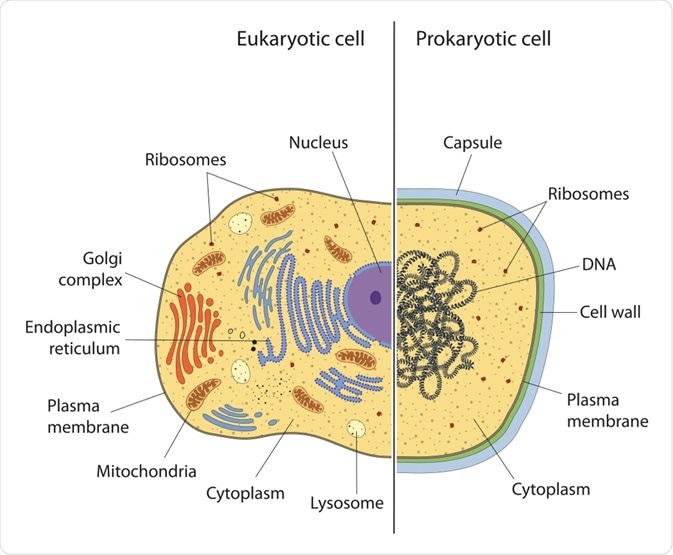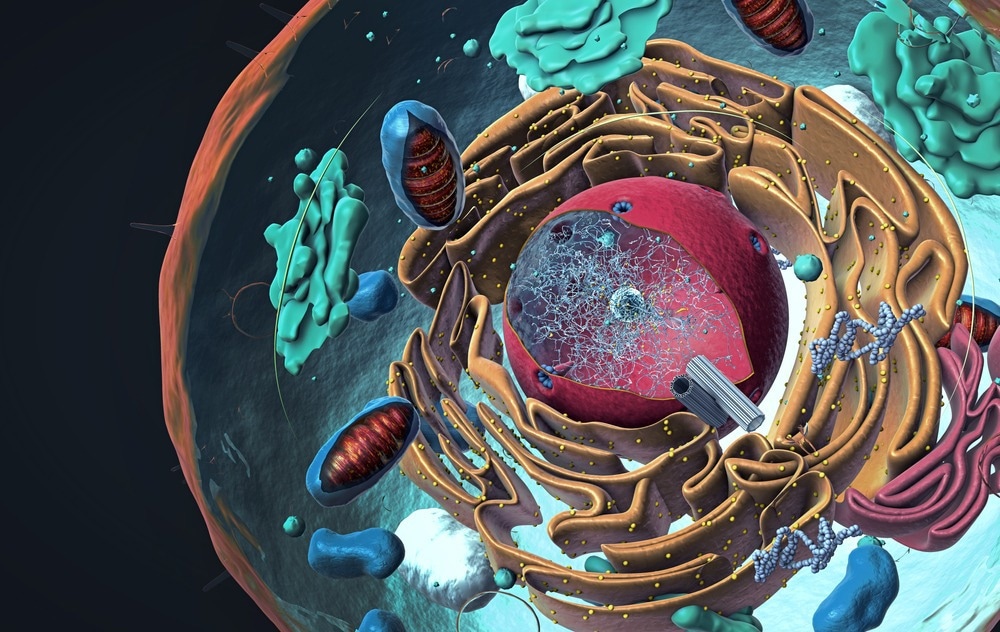Every living organism can be categorized into two groups, namely, prokaryotes and eukaryotes. Most single-celled organisms such as bacteria and archaea are examples of prokaryotic cells, whereas, animal cells, fungi, and plant cells are common examples of eukaryotic organisms. There are many similarities and dissimilarities between these two cell types. This article discusses various aspects of prokaryotic and eukaryotic cells.

Eukaryotic vs Prokaryotic Cell. Image Credit: Aldona Griskeviciene/Shutterstock.com
A prokaryotic cell is believed to be the first form of life. There are many hypotheses associated with the origin of life. One such hypothesis indicates that eukaryotes evolved from prokaryotes around 2.7 billion years ago.
Cellular Components of Eukaryotes and Prokaryotes
In general, every cell has four major components:
- Plasma membrane - the outer covering of the cell that separates the interior cellular components from the surrounding environment.
- Cytoplasm - a jelly-like constituent of the cell where all cell organelles are present.
- DNA - the genetic material of the cell.
- Ribosomes - the cell organelles that are involved with protein synthesis. Ribosomal units of prokaryotic cells are different from eukaryotic cells.
Insight into Prokaryotes
As stated above, these are simple, unicellular organisms that lack membrane-bound organelles. The word "prokaryote" means "before the nucleus". Prokaryotic DNA is found to be bundled in the central region of the cell as a darkened region called a nucleoid. These cells are small in size with a diameter ranging between 0.1–0.5 µm. Owing to their small size, movements of various ions and organic molecules that are involved in cellular functions and removal of cellular waste occur quickly.
In addition to the common features that are present in all cell types, i.e., plasma membrane, ribosomes, DNA, and cytoplasm, a common prokaryotic bacterial cell also contains a cell wall, capsules, fimbriae, pili, and flagella. The cell wall provides structure and protection to all the cellular components.
In most bacteria, the cell walls are composed of carbohydrates and proteins (peptidoglycan). All bacteria do not have capsules which is a carbohydrate layer surrounding the cell wall. The presence of capsules helps bacteria to easily adhere to surfaces. Fimbriae are fine, hair-like structures that help with cellular attachment. Similar to the fimbriae, pili (rod-shaped structures) are involved with cellular attachments.
Additionally, they also have a role in DNA transfer, i.e., conjugation (a type of reproduction). Lastly, bacterial locomotion is assisted by thin, tail-like structures known as flagella.
Insight into Eukaryotes
The name “eukaryotes” means "true nuclei". The word "karyote" is derived from ancient Greek and refers to a "kernel". Eukaryotic cells are multicellular, complex cells containing membrane-bound cell organelles, such as a nucleus, mitochondria, etc. In general, these cells are large whose size may range between 10-100 μm.
Every cellular organelle has specialized functions like protein synthesis and energy production. Some eukaryotes such as parasitic protozoa lack both mitochondria and chloroplasts. Molecular evidence has proved that mitochondria and chloroplasts shared an ancient symbiotic relationship between bacteria and early eukaryotes.
Similar to prokaryotic cells, eukaryotic cells also contain plasma membrane, ribosomes, DNA, and cytoplasm. In addition to this, they also contain a nucleus which in turn comprises the genetic material and nucleolus. The main function of the nucleolus is the production of ribosomal RNA.
The cell wall or cytoskeleton provides the structure to the cells. It also plays a vital role in cell division and cell movements. Mitochondria is responsible for the production of energy which is required for all cellular functions. The cytosol is a gel-like substance that is present within the cell and harbors all cell organelles.
The endoplasmic reticulum is a cell organelle whose prime function is cell maturation and transportation. Vesicles and vacuoles are also known to be the membrane-bound sacs that are involved with transportation and storage. In some of the eukaryotic cells, organelles such as Golgi apparatus, chloroplast, and lysosomes are present.
What are the Key Differences Between Eukaryotes and Prokaryotes?
One of the main differences between prokaryotes and eukaryotes is their DNA structure. As stated above, in a prokaryotic cell, genomic DNA is present in the central nucleoid region and is not membrane-bound. However, in eukaryotes, the genetic material is present in the nucleus, a membrane-bound cell organelle. Eukaryotes contain a double-stranded linear DNA, whereas, in prokaryotes, the DNA material is double-stranded and circular.
Some prokaryotic DNA contains a circular plasmid that carries additional genetic information. The packaging of the prokaryotic chromosome in the nucleoid is assisted by nucleoid-associated proteins. These proteins help prokaryotic DNA to form a looped structure. The size of prokaryotic DNA depends on the species and is approximately 160,000 to 12.2 million base pairs.
Prokaryotic DNA contains a lesser number of genes. The functional unit of DNA contains a cluster of genes governed by a single promoter known as operons. The amount of nonfunctional DNA is less. Replication of prokaryotic DNA is relatively simple. The process of replication initiates at a single origin site and therefore, a single replication fork and bubble is formed. DNA polymerase is the enzyme involved in DNA replication.
Eukaryotic DNA is organized into several linear chromosomes. Histones are the packaging proteins involved with the organization of eukaryotic chromosomes inside the nucleus. Eukaryotic DNA contains a large number of base pairs that are tightly coiled and densely packed.
Humans possess around 2.9 billion base pairs that are arranged into 23 homologous chromosome pairs. DNA contains both functional units (exons) and nonfunctional units (introns). The amount of nonfunctional DNA is more. DNA replication occurs at multiple origins of replication. Multiple protein subunits and DNA polymerase families are involved with the replication.

Image Credit: Christoph Burgstedt/Shutterstock.com
Lateral Gene Transfer (LGT) Between Prokaryotes and Eukaryotes
LGT or horizontal gene transfer represents the movement of DNA between diverse organisms. Even though LGTs are primarily recognized within the bacterial domain of life, several inter-domain LGTs are also surfacing rapidly.
LGTs between bacteria (prokaryotes) and complex multicellular organisms (eukaryotes) draw more attention because they contest the long-held dogma that horizontal gene transfer only occurs in closely-related, single-celled organisms. However, more research is required to understand LGT between the two groups of cells.
Sources:
- Sieber, B.K. et al. (2017). Lateral gene transfer between prokaryotes and eukaryotes. Experimental Cell Research, 358, (2), pp 421-426
- Lanka, P. (2017). Difference Between Prokaryotic and Eukaryotic DNA
- Tellez, G. (2014). Prokaryotes versus eukaryotes: who is hosting whom? Frontiers in Veterinary Science, 1, pp 3, DOI=10.3389/fvets.2014.00003
- Fuerst, J. A. (2010). Beyond Prokaryotes and Eukaryotes: Planctomycetes and Cell Organization. Nature Education ,3(9), pp 44
Further Reading
Last Updated: Jul 14, 2022